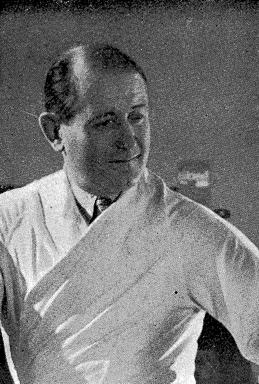Perfume is a mixture of fragrant essential oils or aroma compounds (fragrances), fixatives and solvents, usually in liquid form, used to give the human body, animals, food, objects, and living-spaces an agreeable scent. Perfumes can be defined as substances that emit and diffuse a pleasant and fragrant odor. They consist of manmade mixtures of aromatic chemicals and essential oils. The 1939 Nobel Laureate for Chemistry, Leopold Ružička stated in 1945 that "right from the earliest days of scientific chemistry up to the present time, perfumes have substantially contributed to the development of organic chemistry as regards methods, systematic classification, and theory."

Jean Paul Gaultier is a French haute couture and prêt-à-porter fashion designer. He is described as an "enfant terrible" of the fashion industry and is known for his unconventional designs with motifs including corsets, marinières, and tin cans. Gaultier founded his eponymous fashion label in 1982, and expanded with a line of fragrances in 1993. He was the creative director for French luxury house Hermès from 2003 to 2010, and retired following his 50th-anniversary haute couture show during Paris Fashion Week in January 2020.
Patou, formerly known as Jean Patou or Jean Patou Paris, is a French fashion house.

Guerlain is a French perfume, cosmetics, and skincare house which is among the oldest in the world. Many traditional Guerlain fragrances are characterized by a common olfactory accord known as the "Guerlinade".

Chanel No. 19 perfume was first marketed in 1971. The number 19 was chosen to commemorate Coco Chanel's birthday, 19 August. The perfume was launched a year before she died. The scent was created by Henri Robert.
Jean-Claude Ellena is a French perfumer and writer, he served as the in-house perfumer at Hermes from 2004 and 2019, prior to the appointment of incumbent Christine Nagel

Parfums Givenchy is a French brand of perfumes and cosmetics, known for fragrances L'Interdit, Amarige, Organza, Pi, and Givenchy III. As part of Givenchy, it has been a subsidiary of LVMH since 1988.

Nina Ricci is a fashion house founded by Maria "Nina" Ricci and her son Robert in Paris in 1932, and owned by the Spanish beauty and fashion group Puig since 1998.

Lolita Lempicka is a French fashion designer and perfumer.

Joy is a perfume created for Parisian couturier Jean Patou by perfumer Henri Alméras in 1929. It is considered to be one of the greatest fragrances created and is a landmark example of the floral genre in perfumery. It is no longer produced.

Henri Alméras was a French perfumer, author, and painter.
Jean Kerléo is a French perfumer who worked in-house of Jean Patou and is also the founder of the Osmothèque, a scent archive in Versailles. Kerleo was born on 24 February 1932 in Brittany, France. At age 22, he began making perfumes for a New York City company, Helena Rubenstein. He received the Prix des Parfumeurs de France in 1965, served as the president for the Society of French Perfumers from 1976 to 1979, and was awarded the Prix François COTY in 2001
Ybry is a French luxury perfume and fashion house founded in 1925 by Simon Jaroslawski. It formerly resided at 6 rue Ybry, Neuilly (Seine). In 2005 the brand was revitalized and the trademark and original bottle designs were filed for international protection. Amanda Witteman is the company's spokesmodel.

The Osmothèque is the world's largest scent archive, a leading international research institution tracing the history of perfumery, based in Versailles with conference centers in New York City and Paris. Founded in 1990 by Jean Kerléo and other senior perfumers including Jean-Claude Ellena and Guy Robert, the Osmothèque is internationally responsible for the authentication, registration, preservation, documentation and reproduction of thousands of perfumes gathered from the past two millennia, archived at the Osmothèque repository and consultable by the public.

The House of Worth was a French fashion house that specialized in haute couture, ready-to-wear clothes, and perfumes. It was founded in 1858 by English designer Charles Frederick Worth. It continued to operate under his descendants until 1952 and closed in 1956. The House of Worth fashion brand was revived in 1999.
Jacques Cavallier-Belletrud is a French perfumer formerly with the Swiss fragrance and flavor company Firmenich, who currently works for Louis Vuitton of the LVMH Luxury Group.
Chanel Chance is a line of fragrances for women from Chanel that was introduced in September 2002. It was created by Jacques Polge, who has created every Chanel fragrance launched since 1978, including Coco Mademoiselle, Allure, Bleu de Chanel and Chanel No.5 Eau Premiere.
Miss Dior is a 1947 perfume released by Christian Dior.

Classique is a women's fragrance created by Jacques Cavallier for Jean Paul Gaultier in 1993. It has been manufactured by Puig since 2016, and was previously manufactured by Shiseido subsidiary Beauté Prestige International from 1995 until 2015. The men's fragrance Le Male was developed as a counterpart to Classique, and was introduced in 1995.

Miss Dior Chérie was a fragrance created by Christine Nagel for Christian Dior. At the time John Galliano served as Dior’s fashion designer and creative director, overseeing Nagel’s development of the unusual, youth-oriented strawberry-and-popcorn eau de parfum. Miss Dior Chérie was available from 2005 to 2011: after perfumer François Demachy joined Dior, Miss Dior Chérie was reformulated and renamed Miss Dior.















